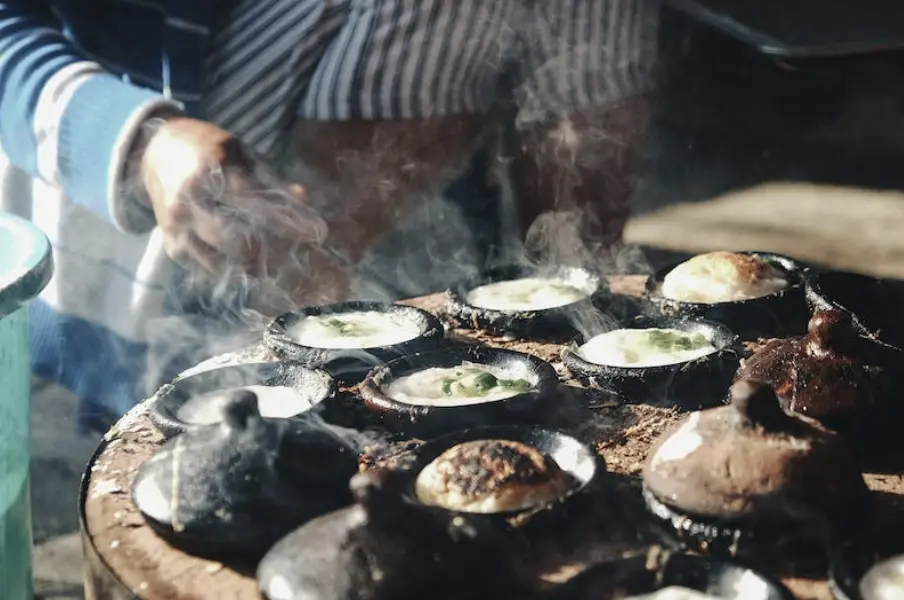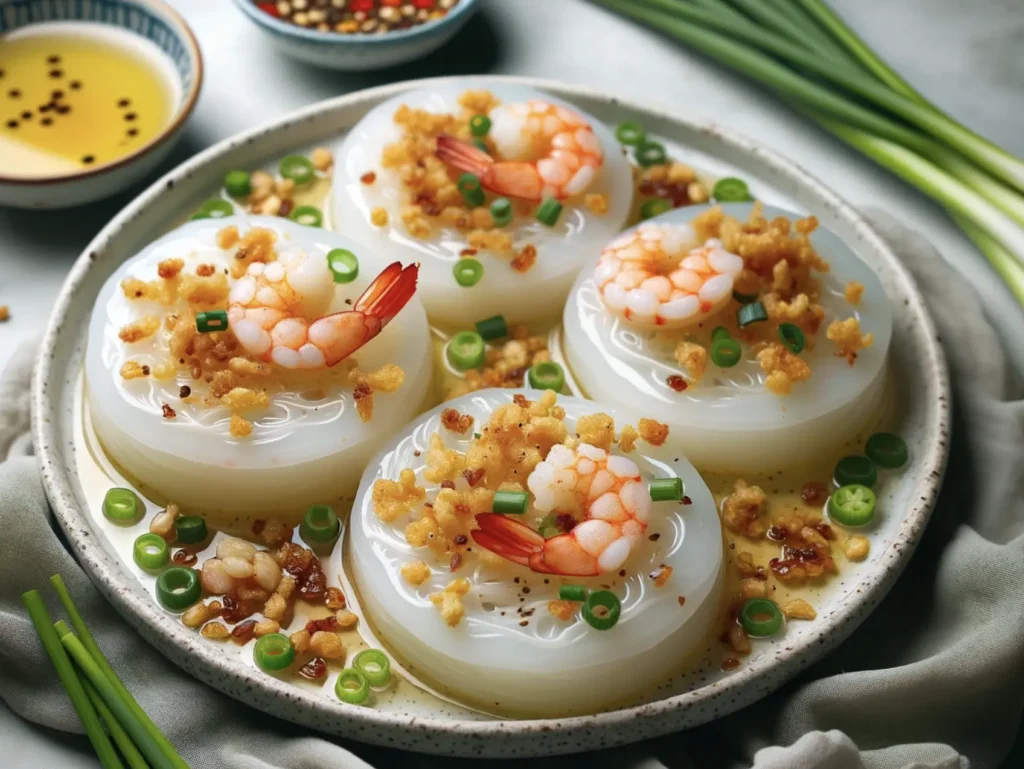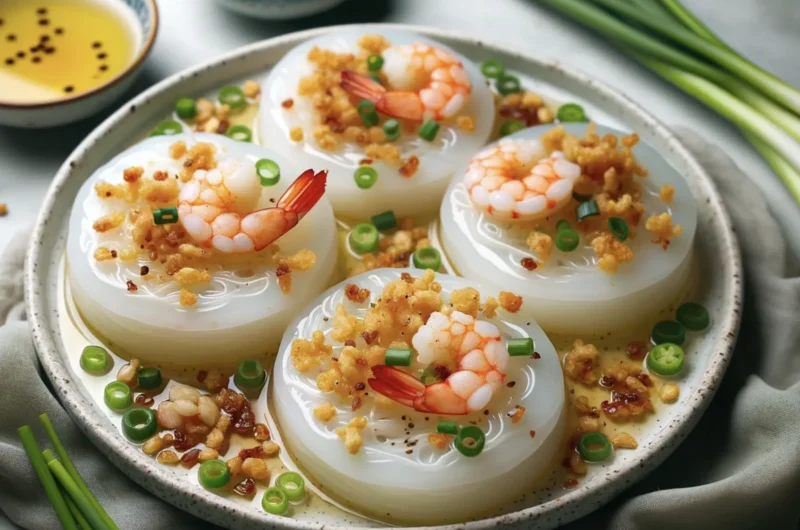Steaming Stories: Introduction to Vietnamese Steamed Rice Cakes
Chances are you’ve probably tried very little when it comes to Vietnamese cuisine. And my question to you is: Why haven’t you?? Vietnamese cuisine is a rich tapestry of flavors, techniques, and traditions. Not to mention super delicious! One food that is at the center of Vietnamese cooking is the steamed rice cake; a delicious dish that has been passed down through generations. These Vietnamese Steamed Rice Cakes, especially Bánh Bèo, hold a special place in the hearts of Vietnamese people.
Street vendors in Central Vietnam serve these with passion, and little kids often gather around, eagerly awaiting their turn to dig into this delicacy.
The cultural significance of Vietnamese Steamed Rice Cakes, especially Bánh Bèo, can’t be ignored. Often referred to as “cow cakes” because of their shape, these cakes are not just food; they’re a slice of history, memories of family gatherings, and a symbol of Vietnamese tradition.
The soft rice cake, with its delicate white color, often reminds Vietnamese people of their childhood, running around and playing while their grandparents prepared this delicious dish in the kitchen.
As a glimpse into the world of Vietnamese Steamed Rice Cakes, we will share everything you need to know about the classic Bánh Bèo so that you are well prepared when recreating this amazing dish in your own kitchen! Did I mention we have the ultimate Vietnamese Steamed Rice Cakes recipe in this article! Share it with other adventurous cooks you know that love tasty and special dishes.
Bánh Bèo Beginnings: An Ode to the Classic
Tracing back to the roots of Bánh Bèo, this dish originated from Central Vietnam. The name “Bánh Bèo” translates to “water fern cake” due to its resemblance to small water ferns found in Vietnamese ponds. It’s a type of soft rice cake made primarily from rice batter, usually served in small bowls. Its texture is reminiscent of Japanese mochi, but with its own unique twist.
The sensory experience of Bánh Bèo is truly unparalleled! When prepared correctly, it offers a chewy yet soft texture, complemented perfectly by the flavorful toppings of fried shrimp, scallion oil, and crispy pork fat. The dipping sauce, often a blend of fish sauce, lime juice, and black pepper, elevates the dish to a whole new level. Each bite is a delightful mix of savory, spicy, and slightly sweet flavors.
While Bánh Bèo has found its way into many Vietnamese households, there are slight variations in how it’s made and served. In some regions, you’ll find the addition of mung bean paste, while in others, the inclusion of ground pork or prawn floss adds a meaty dimension. However, the Bánh Bèo recipe’s main ingredients remain consistent: rice flour, tapioca starch, and toppings that bring it to life.

Photo Credit: Duong Nhan
Ingredients Insight: The Building Blocks of Bánh Bèo
The magic of Bánh Bèo lies in its ingredients, and the first and foremost is rice flour. For the best results, many chefs recommend using a combination of rice flour and tapioca starch. The rice flour provides the base, while the tapioca starch lends it a slightly chewy texture. It’s essential to combine rice flour with warm water, ensuring that the batter is smooth and lump-free.
A trip to local Asian grocery stores or Vietnamese grocery stores will usually yield all the ingredients needed for Bánh Bèo. Mung beans are another crucial component, often mashed into a paste and used as a topping. Their taste is truly unique from the other bean pastes you may have tried. These beans, combined with coconut milk and sugar mixture, create a rich and flavorful mung bean paste that contrasts beautifully with the soft rice cake’s neutral taste.
Then come the toppings! Traditional Bánh Bèo is graciously topped with a mix of fried shrimp, crispy shallots, and crispy pork skin. Each topping adds a layer of complexity to the dish. The shrimp offers a salty burst, while the crispy pork skin adds a delightful crunch. And no Bánh Bèo is complete without its dipping sauce! This sauce, traditionally a blend of fish sauce, garlic, and chili, is the heart and soul of the dish, tying all the flavors together.
The Steam Scene: Perfecting the Art of Steaming Bánh Bèo
When it comes to making Bánh Bèo, the steaming process is really important. Achieving that perfect soft yet chewy texture is, I’m not going to lie, a lot of work and can take some patience, but the results are well worth the effort. It’s essential to have a good steamer, preferably one that can maintain high pressure. Many Vietnamese families use traditional steamers, often lined with banana leaves, to infuse the cakes with a subtle aroma. But, an Instantpot or other electric steamer will do just fine.
Getting the batter consistency right is the next challenge. It’s a balance of water, rice flour, and tapioca starch that must be just right. Once mixed, it’s crucial to let the batter rest at room temperature. This rest period allows the ingredients to meld, resulting in a smoother texture when steamed. Before steaming, many chefs also add a touch of food coloring, usually green, giving Bánh Bèo its signature hue. It’s totally fine to skip this part though.
Timing is everything when steaming Bánh Bèo. Too long, and you risk overcooking them, leading to a rubbery texture. Too short, and they might be undercooked. The trick is to watch them closely, ensuring they’re steamed just right. Once done, they should be removed from the steamer and allowed to cool slightly before being served.
Molding Magic: Crafting the Perfect Shape
In the bustling street vendors of Central Vietnam, the delicate process of molding the perfect Bánh Bèo is an art form passed down through generations. These small bowls of joy, often referred to as “cow cakes” by the Vietnamese people, capture the essence of traditional culinary craftsmanship. Using banana leaves as molds, a method deeply rooted in tradition, imparts a subtle fragrance to the cooked rice cake, enhancing its authentic flavor profile.
The modern foodie, however, often resorts to silicone molds, readily available at local Asian grocery stores or online. However, there’s a nostalgic charm in using banana leaves, reminding many Vietnamese people of their childhood days, watching their grandparents meticulously shape each Bánh Bèo.
Banana leaves or silicone?
For those who like to stick to tradition, securing banana leaves can be a bit of a quest. Still, Asian markets, especially Vietnamese grocery stores, often carry these leaves, either fresh or frozen. When using banana leaves, ensure they’re at room temperature. Gently wash each leaf and pat them dry. Then, cut them into circles slightly larger than your small bowls or molds. If banana leaves are hard to find, plastic wrap can be used as a makeshift alternative, though it won’t impart the same aromatic touch.
Once the molds or banana leaves are prepped, the next step is the rice batter. The main ingredients include rice grains, tapioca starch, and hot water. Some slight variations of the Bánh Bèo recipe might call for adding coconut milk to the batter for a creamier texture and richer taste. It’s essential to mix the ingredients in a food processor until smooth, ensuring there are no lumps. The consistency should be similar to pancake batter – not too thick, not too runny. Letting the batter rest for a few hours or even overnight in an airtight container allows the flavors to meld and results in the best steamed rice cakes.

Photo Credit: Lan Yao
Glorious Garnishes: Mastering the Toppings for Vietnamese Steamed Rice Cakes
And, who can resist the allure of toppings! They can make or break a dish, and when it comes to the Banh Beo, they’re the crown jewels. The main ingredients of these toppings often include succulent shrimp, crispy pork fat, and fragrant scallion oil. The shrimp, usually sourced from local Vietnamese grocery stores, is seasoned with a dash of black pepper and quickly sautéed on medium-high heat until it achieves a delightful golden hue.
To add that extra crunch, crispy pork fat and fried shallots are sprinkled generously over the cooked rice cake. And let’s not forget the scallion oil, a fragrant concoction made by sautéing green onions in vegetable oil over low heat, which adds a layer of aromatic delight.
Now, let’s chat about mung beans. These tiny legumes, found in abundance at Asian markets, are transformed into a savory mung bean paste that’s smooth as silk. After soaking the beans overnight, they’re blended in a food processor to achieve a fine consistency, then cooked with a bit of salt and fried shallots. This paste is then cooled to room temperature and stored in an airtight container. A spoonful of this paste on top of the Banh Beo is a match made in heaven.
Lastly, you might come across Bánh Bèo with a dash of prawn floss. This ingredient, although not traditional in Central Vietnam, has become a beloved topping in the present day. Made by drying and finely grinding shrimp, this floss adds an umami punch to the delicate rice cakes. Try it sometime. You might be surprised!
Saucy Secrets: Creating the Perfect Dips
Dipping sauces are the unsung heroes of Vietnamese cuisine. Well, should I say every cuisine, for that matter! For the Banh Beo, the sauce is a tantalizing blend of fish sauce, garlic, and chili. Fish sauce, a staple in Vietnamese kitchens, serves as the base.
Fish sauce is actually available in most grocery stores these days and is used in most Asian food dishes. To this sauce, crushed garlic, a sprinkle of sugar, and a dash of lime juice are added. The balance is crucial: the saltiness of the fish sauce, the tang of the lime, and the kick from the chili must work. For slight variations in the dipping sauce, consider a splash of soy sauce or a hint of black pepper.
Pro tip: always make your dipping sauces a day in advance and store them in an airtight container. This little trick allows the flavors to meld beautifully, ensuring that each dip is packed with flavor.
Modern Twirls on Traditional Tastes: Innovations and Twists
In the present day, many chefs have begun putting their own version of this dish on the map. With simple ingredients sourced from local Asian grocery stores, creative minds have given birth to slight variations of the classic Bánh Bèo recipe. Lucky us! More versions to try! Some have introduced the rich creaminess of coconut milk to the rice batter, while others have experimented flavors of Japanese mochi.
Street vendors, especially, have been quick to adopt these changes, ensuring Vietnamese steamed rice cakes remain a sought-after street food.
To get the best results at home, many turn to cooking videos and blogs, diving deep into the world of Vietnamese desserts. From using a food processor to blend sticky rice grains to perfection, ensuring the rice batter achieves a milky white color, to letting the batter rest under plastic wrap at room temperature for just the right amount of time, every detail matters.
And with the plethora of ingredients available in Vietnamese grocery stores and Asian markets nowadays, crafting your delicious dish has never been easier.
FAQs
1. How Do You Eat Vietnamese Rice Cake?
Vietnamese rice cakes, a delightful staple, are traditionally enjoyed in various ways. Here’s a bite-sized guide:
- Served as is: Relish them plain to appreciate their subtle flavor.
- With Dips and Sauces: Elevate the taste by dipping them in savory sauces like fish or soy sauce.
- Accompaniments: Pair with fresh herbs, pickled vegetables, or meats for a complete meal.
- In Soups: Chop and add to soups for a comforting and filling twist.
2. What Is the Difference Between Banh Tet and Banh Chung?
- Shape and Size: Banh Tet boasts a cylindrical shape, while Banh Chung is proudly square.
- Historical Roots: Banh Chung is linked to the Lunar New Year and rich in tradition, symbolizing the Earth. Banh Tet, often enjoyed in Southern Vietnam, represents the moon.
- Filling and Wrapping: Both feature glutinous rice, mung beans, and pork, but their preparation and regional variations create distinct flavors.
| Feature | Banh Tet | Banh Chung |
|---|---|---|
| Shape | Cylindrical | Square |
| Region | Southern Vietnam | Throughout Vietnam |
| Occasion | Commonly enjoyed at Tet (Lunar New Year) | Specifically for Tet (Lunar New Year) |
| Ingredients | Glutinous rice, mung beans, pork | Glutinous rice, mung beans, pork |
| Symbolism | Represents the moon | Symbolizes the Earth |
| Preparation | Wrapped in banana leaves | Also wrapped in banana leaves |
| Serving Style | Sliced into rounds | Cut into squares or rectangles |
3. What Is Banh Bo Made Of?
- Main Ingredients: A sweet symphony of rice flour, coconut milk, and sugar.
- The Secret Ingredient: Fermented rice adds a unique, slightly tangy flavor.
- Texture and Taste: Expect a spongy texture and a delightful sweetness, often complemented by a hint of pandan or vanilla.
4. How Do You Eat Steamed Rice Cakes?
- As a Snack: Just steam and enjoy! They’re perfect for a light, satisfying nibble.
- With Toppings: Get creative with coconut shreds, sesame seeds, or a drizzle of sweet syrup.
- In Savory Dishes: Slice and incorporate into stir-fries or top with meat and veggies for a hearty meal.
- Dessert Style: Pair with fruits and sweet sauces for a delightful dessert.
5. How Many Calories in a Vietnamese Rice Cake?
- Caloric Content: A typical Vietnamese rice cake has approximately 100-150 calories per serving.
- Nutrition Breakdown: Low in fat but rich in carbohydrates, they provide a quick energy boost.
- Diet-Friendly? Great for a light snack, but watch portion sizes if you’re calorie-conscious.
Rice Cake Ready?
These dishes, with their simple ingredients and intricate flavors, are a testament to the rich culinary heritage of Vietnam. And while they are deeply rooted in tradition, the modern twists and innovations ensure they remain relevant, and loved by both the young and old.
For all you cooks out there eager to try your hand at making these delicacies, remember, it’s all about the love and passion you pour into the process. Whether you’re following your grandmother’s age-old recipe or adding your unique spin, the end goal remains the same: to create a dish that not only satiates the palate but also warms the heart.
So, what are you waiting for? Find a local Asian grocery store, grab the ingredients, roll up your sleeves, and get cooking! Who knows, you might just find your new favorite savory Asian dish! Share your experience cooking this dish in the comments and share this recipe!
Traditional Bánh Bèo (Vietnamese Steamed Rice Cakes) Recipe
Course: Dinner, Lunch4
servings30
minutes40
minutes300
kcalBest enjoyed fresh and warm, paired with the tangy dipping sauce.
Ingredients
For the Rice Cakes:
1 cup rice flour
2 tbsp tapioca starch
1.5 cups cold water
1/2 tsp salt
1 cup boiling water
For the Toppings:
1/2 cup dried shrimp, finely minced
2 green onions, finely chopped
1/4 cup crispy pork fat or vegetable oil
1/4 cup fried shallots
A pinch of black pepper
For the Dipping Sauce:
3 tbsp fish sauce
1 tbsp sugar
1/2 cup water
2 cloves garlic, minced
1 chili pepper, finely chopped (adjust to taste)
1 tbsp lime juice
Directions
- Prepare the Batter:
- In a mixing bowl, combine rice flour, tapioca starch, and salt.
- Slowly add in the cold water, mixing well to ensure there are no lumps.
- Pour in the boiling water and stir continuously until you get a smooth batter. Let the batter rest for about 30 minutes.
- Prepare the Toppings:
- In a pan on medium heat, add a bit of oil and sauté the dried shrimp until they turn golden. Remove and set aside.
- In the same pan, add a bit more oil and sauté the green onions until they become fragrant. Remove from heat and mix with the crispy pork fat or vegetable oil. This is your scallion oil.
- Steam the Rice Cakes:
- Lightly grease small bowls or bánh bèo molds with a bit of oil.
- Fill each bowl about halfway with the batter.
- Place the bowls in a steamer (make sure the steamer is already emitting a steady stream of steam).
- Steam for about 10-15 minutes or until the cakes become translucent.
- Once cooked, remove from the steamer and let them cool for a few minutes.
- Prepare the Dipping Sauce:
- In a bowl, combine fish sauce, sugar, water, minced garlic, chili pepper, and lime juice. Stir well until the sugar dissolves completely. Adjust to taste.
- Assemble and Serve:
- Once the rice cakes have cooled a bit, top each with some minced shrimp, a drizzle of scallion oil, fried shallots, and a sprinkle of black pepper.
- Serve with the dipping sauce on the side.
Craving more delicious recipes? Try these: Guyanese Garlic Pork

